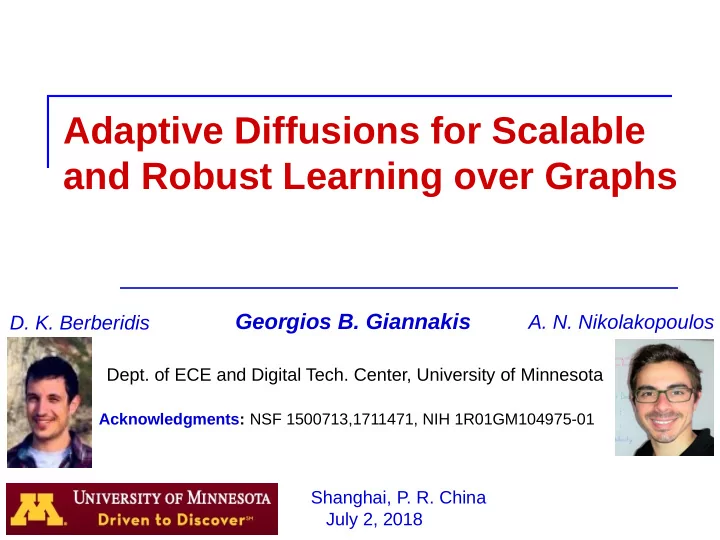

Adaptive Diffusions for Scalable and Robust Learning over Graphs ICASSP2017 Georgios B. Giannakis A. N. Nikolakopoulos D. K. Berberidis Dept. of ECE and Digital Tech. Center, University of Minnesota Acknowledgments: NSF 1500713,1711471, NIH 1R01GM104975-01 Shanghai, P. R. China July 2, 2018
Motivation Graph representations Real networks Data similarities Objective: Learn values or labels of graph nodes, as e.g., in citation networks Challenges: Graphs can be huge and are scarcely labeled Due to privacy, cost of battery, (un) reliable human annotators … 2
Problem statement Graph Weighted adjacency matrix Label per node Topology given or identifiable Given in e.g. WSNs and social nets Identifiable via e.g., nodal similarities Goal : Given labels on learn unlabeled nodes 3
Work in context Non-parametric semi-supervised learning (SSL) on graphs Graph partitioning [Joachims et al ‘03] Manifold regularization [Belkin et al ‘06] Label propagation [Zhu et al’03, Bengio et al‘06] Bootstrapped label propagation [Cohen‘17] Competitive infection models [Rosenfeld‘17] Node embedding + classification of vectors Node2vec [Grover et al ’16] Planetoid [Yang et al ‘16 ] Deepwalk [Perozzi et al ‘14] Graph convolutional networks (GCNs) [ Atwood et al ‘16], [ Kipf et al ‘16] 4
Random walks on graphs Position of random walker at step k : Transition probabilities Steady-state probs. Presumes undirected, connected, and non-bipartite graphs Not informative for SSL Step- k landing probabilities Measure influence of on every node in - informative for SSL! 5
Landing probabilities for SSL Random walk per class with Initial (“root”) probability distribution Per step landing probabilities found by multiplying with sparse H Family of per-class diffusions Valid pmf with K -dim probability simplex Max-likelihood per-node classifier 6
Unifying diffusion-based SSL Special case 1: Personalized page rank (PPR) diffusion [Lin‘10] Pmf of random walk with restart probability 1- α ; in steady-state Special case 2: Heat kernel (HK) diffusion [Chung’07] “Heat’’ flowing from roots after time t ; in steady-state HK and PPR have fixed parameters Our key contribution : Graph- and label-adaptive selection of 7
Adaptive diffusions Normalized label indicator vector AdaDIF scalable to large-scale graphs ( K << N ) Linear-quadratic ``Differential’’ landing prob. 8
AdaDIF in a nutshell 9
Interpretation and complexity For (smoothness-only), Weight concentrates on last landing prob. For (fit-only) Weight concentrates on first few landing probs Intuition: very short walks visit similarly labeled nodes AdaDIF targets a “sweet-spot” between the two Simplex constraint promotes sparsity on If , per-class complexity thanks to sparsity of H Same as non-adaptive HK and PPR; also parallelizable across classes Reflect on PPR and Google … just avoid K >> 10
Boosting AdaDIF Dictionary of D << K diffusions Dictionary may include PPR, HK, and more Complexity Unconstrained diffusions (relax simplex constraints ) Retain hyperplane constraint to avoid all-zero solution Closed-form solution 11
On the choice of K Definition. Let and denote respectively the seed vectors for nodes of class “+’’ and “-,’’ initializing the landing probability vectors in matrices , and , , .. With and , the -distinguishability threshold of the diffusion-based classifier is the smallest integer satisfying Theorem. For any diffusion-based classifier with coefficients constrained to a probability simplex of appropriate dimensions, it holds that and eigenvalues of the normalized graph Laplacian in ascending order. Message: Increasing K does not help distinguishing between classes Large K may even degrade performance due to over-parametrization 12
In practice 13
Contributions and links with GSP AdaDif vis-à-vis graph filters [Sandryhaila-Moura ‘13, Chen et al ‘14] Different losses and regularizers, including those for outlier resilience Multiple class case readily addressed AdaDif’s simplex constraint can afford Random walk interpretation Search space reduction Rigorous analysis using basic graph properties AdaDif vis-a-vis GCNs Small number of constrained parameters: reduced overfitting Simpler and easily parallelizable training: no back propagation No feature inputs: operates naturally on graph-only settings 14
Real data tests Real graphs Citation networks Blog networks Protein interaction network Micro-F1: node-centric accuracy measure Macro-F1: class-centric accuracy measure HK and PR run with K = 30 for convergence AdaDIF relies just on K = 15 15
Multiclass graphs State-of-the-art performance Large margin improvement over Citeseer 16
Multilabel graphs ❑ Number of labels per node assumed known (typical) ➢ Evaluate accuracy of top-ranking classes ❑ AdaDIF approaches Node2vec Micro-F1 accuracy for PPI and BlogCatalog ➢ Significant improvement over non-adaptive PPR and HK for all graphs ❑ AdaDIF achieves state-of-the-art Macro-F1 performance 17
Runtime comparison AdaDIF can afford much lower runtimes Even without parallelization! 18
Leave-one-out fitting loss Quantifies how well each (labeled) node is predicted by the rest ‘s obtained via different random walks ( ) Compact form Diffusion parameters 19
Anomaly identification - removal Model outliers as large residuals, captured by nnz entries of sparse vec. Joint optimization Group sparsity on While, iterate: i.e., force consensus among classes regarding which nodes are outliers Residuals Row-wise soft-thresholding Alternating minimization converges to stationary point Remove outliers from and predict using 20
Testing classification performance Anomalies injected in Cora graph Go through each entry of With probability draw a label Replace For fixed , accuracy with improves as false samples are removed Less accuracy for (no anomalies), only useful samples removed (false alarms) 21
Testing anomaly detection performance ROC curve: Probability of detection vs probability of false alarms As expected, performance improves as decreases 22
Research outlook Investigate different losses and diverse regularizers Further boost accuracy with nonlinear diffusion models Effect reduced complexity and memory requirements via approximations Online AdaDIF for dynamic graphs 23
Recommend
More recommend